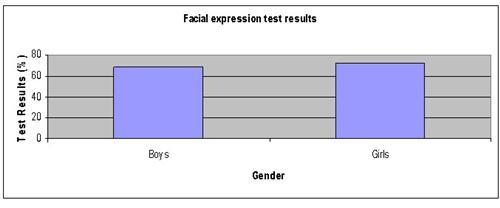| Complexity level: | 3 |
| Project cost ($): | 20 |
| Time required: | 1 hour for preparation, 2 days for experiment |
| Material availability: | Easily found |
| Safety concerns: | None |
Hypothesis
The girls will be able to identify the facial expressions more accurately than the boys.
Overview
Facial expression
Facial expression is a form of non-verbal communication where the movement of the muscles and skin on the face are able to convey certain emotions to an onlooker or observer. Examples of facial expressions that are normally encountered are faces of happiness, anger, worry, surprise, fear and sadness. The significance and meanings of facial expressions may vary among different cultures and ethnic groups.
Some facial expressions are made voluntarily to express or convey a certain message to the observer. An example of this behavior is when we greet someone with a smile, or frown to express our disapproval. However, most of the time, facial expressions are involuntary and are triggered by an emotional response to an event. In such cases, even if we try to hide it, a brief change in facial expression will normally occur before we are able to eventually control or alter the expression.
Facial expressions are also useful for the perceiver because it will enable her to know if something is disturbing or upsetting a person. They provide clues to a person’s true feelings, and may act as a hint to the perceiver to react accordingly.
Scientific Terms
Materials
The materials required for this science fair project:
- 10 boys, 15 years of age
- 10 girls, 15 years of age
- 25 photos of facial expressions compiled into a test paper
- A computer
- An examination hall with tables and chairs
- A stopwatch
Procedure
1. For this science fair project, the independent variable is the gender of the participants. The dependent variable is the number of facial expressions identified correctly by the students. This is determined by checking the answers given by the students. The constants (control variables) are the age of the students, the number of different facial expressions given to them to identify and the time given to them to identify the expressions.
2. Randomly select 10 boys and 10 girls age 15 to take part in this experiment. Search the internet for 25 photos of faces making different facial expressions. Compile them into a test paper for participants to guess what each facial expression means. Number the pictures and provide blanks next to each picture. Make 20 copies of the test and create an answer key.
3. Assemble all 20 students in the exam hall. Distribute the test papers and give the students 1 hour to complete the test.
4. Mark the tests using the answer key and calculate the average score for each gender. Record your results in a table, as shown below.

Results
The results show that the average scores of the girls were slightly higher than the boys.
| Description | Average results for the facial expression test (%) | |
| Boys | Girls | |
| Test results | 68.5 | 72 |
The above results were then plotted onto a graph, as shown below.

Conclusion
The hypothesis that girls would be able to identify facial expressions more accurately than boys, has been proven to be true.
Facial expressions are a useful way of expressing feelings or one’s emotional state without speaking. Emotions easily expressed can include love, hatred, anger, fear and surprise. Sometimes, facial expressions are used by parents and teachers to indicate to children that they are doing something wrong. Animals also use facial expressions to demonstrate anger, or to protect their territory and offspring.
Also consider
The science fair project can be repeated on students from different age groups.
The experiment may also be repeated with a larger group of students and with a different set of photos.
References
Facial expression - http://en.wikipedia.org/wiki/Facial_expression
Facial expression – a primary communication system - http://www.face-and-emotion.com/dataface/expression/expression.jsp

